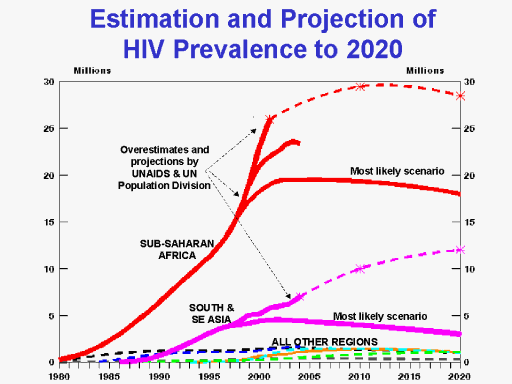| front |1 |2 |3 |4 |5 |6 |7 |8 |9 |10 |11 |12 |13 |14 |15 |16 |17 |18 |19 |20 |21 |22 |23 |24 |25 |26 |27 |28 |29 |30 |31 |32 |33 |review |
 |
The Most Probable Future of the AIDS Pandemic - UNAIDS finally
in May 2006 acknowledged that annual global HIV incidence peaked by
the late 1990s, but their press releases and HIV projections have
not been flooding the news media with any major revisions from their
“ever-increasing and ever-expanding” rhetoric.
Regardless of what UNAIDS may or may not say, the following
are my projections for the AIDS pandemic for the next couple of
decades. I envision a dwindling pandemic but still one that requires
an unprecedented public health response.
Regional and
national
patterns
of HIV/AIDS established during the 1980s/1990s will continue almost unchanged
over the next few decades.
Annual HIV incidence in all regions will be either decreasing or remain
relatively stable but at lower levels compared to the 1980s and
1990s.
“Nonepidemic” (R0 <1)
HIV transmission, from persons infected as a result of their risk behaviors, to
their regular sex partners (discordant couples) in populations where HIV
epidemics have occurred as well as in populations where no HIV epidemics have
occurred will continue to be a major, if not the major mode of HIV transmission
throughout the world. There will continue to be an unacceptably high “endemic”
HIV level in most SSA countries, several Caribbean countries, a few Asian
countries, and in most MSM and IDU populations throughout the world.
|